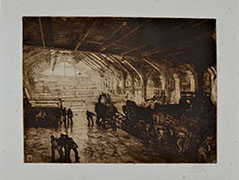Milan 1884 - 1960
After an apprenticeship in his father’s workshop, a craftsman specializing in wrought iron work, Greppi enrolled at the Brera Academy as a pupil of Camillo Boito. He graduated in 1907, obtaining the license of professor of architectural drawing. He began working in the studio of the architect Raimondo d’Aronco and obtained several commissions and awards, including an annual pension to travel abroad. Thanks to this pension he was able to go to Paris and attend the École des beaux-arts, from 1908 to 1910, then to Constantinople and Rome. At the same time he developed a true passion for painting, particularly for the watercolor technique and also for etching, which he used more in a personal than professional context. In 1915 Greppi participated in the Mostra Nazionale dell'incisione, Milan and, in 1916, in the Esposizione dell'associazione italiana acquafortisti e incisori in London With the outbreak of the First World War, Greppi was commissioned to create some etchings, later collected in the volume L'industria italiana per la guerra 1915-18 (Milan 1926). In 1918 he received the important assignment to create the etching with the Bollettino della vittoria by A. Diaz.
After this experience, his work will be exclusively dedicated to architecture. In 1931 he designed the new headquarters of the Banca Popolare di Milano in Piazza Crispi. After this important work experience he also won the competition for the design of the new headquarters of the Cassa di risparmio in Via Verdi, also in Milan. In 1940 he received the important assignment to create a factory city for Dalmine, a company producing steel tubes, in the province of Bergamo.The projects that made Greppi famous, however, were the military shrines, including the military shrine of Monte Grappa, the one at Pian di Salisei, Timau, Caporetto and San Candido. The most famous, however, remains the military shrine built in 1938 in Redipuglia, the largest existing military shrine in Italy.
